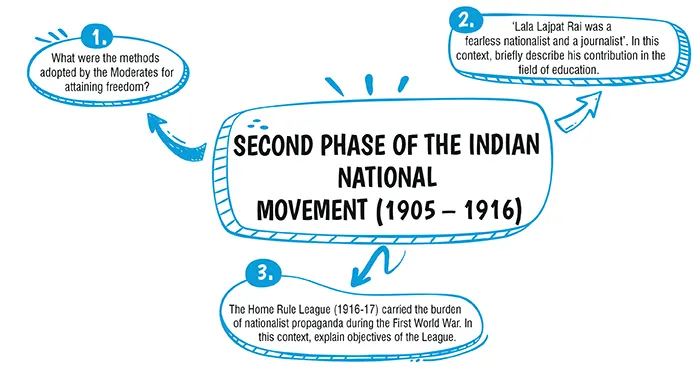Home / Board / ICSE / important Questions / Class 10 / History & Civics / Second phase of the indian national movement (1905 – 1916)
Table of Contents

Ans. (b) Extremists’ lack of faith in the capacity of the moderates to negotiate with the British Government
Explanation:
The Indian National Congress (INC) divided into two factions, the extremists and the moderates, during the Surat Session in 1907 due to a dispute over the election of the INC President. The moderates supported Lala Lajpat Rai, while the extremists favoured Dr. Rash Behari Ghosh, who eventually won the election. This disagreement over the presidency led to the split in the INC.
Ans. (d) Muslims
Explanation:
To prevent the rise of any feeling of hostility between Muslims and other communities, without adversely affecting the aforesaid objectives of the League.
Explanation:
Methods adopted by the Early Nationalists in the National Movement were:
1. The first set of methods was to educate people in India in modern politics to arouse national political consciousness and to create united public opinion.
2. They made use of three P’s—petitions, prayers and protest. They sent petitions,requests and letters of protest to the British government and forced them to look into the problems of the Indians.
Explanation:
Lala Lajpat Rai was born in 1865 in Jagraon in Punjab. He was a lawyer by profession. He was a great scholar as well. He wrote ‘The Arya Samaj’ and ‘England’s Debt to India’. He opened orphanages, schools and hospitals. He set up ‘Servants of the People’s Society’ for the welfare of the untouchables and the downtrodden. He cooperated wholeheartedly with Madan Mohan Malaviya in fighting illiteracy in India. Madan Mohan Malaviya laid the foundation of Banaras Hindu University and Lala Lajpat Rai laid the Foundation of DAV College, Lahore. He believed in Hindu-Muslim unity.
Explanation:
The following were the objectives of the Home Rule League :
(i) To attain Self-Government at all Levels : Home Rule Leagues aimed at securing self-government for India at all levels.
(ii) To attain Self-Government and not Complete Independence : They aimed to secure self government within the British Empire, and not complete independence.
(iii) To check Revolution in Indian Politics : The aim of the Home Rule Leagues was also to check terrorism in Indian politics. Mrs. Annie Besant felt that in the absence of a peaceful and Constitutional agitation, there would be dominance of revolutionaries over Indian politics.
(iv) To use Peaceful and Constitutional means : The Home Rule Leagues believed in peaceful and Constitutional agitations to achieve their goal of self-government.
(v) To awaken masses : Some time there was a lull in Indian politics. The objective of the Home Rule Leagues was to awaken the sleepy Indians so that they could work for their motherland. The idea was to organise mass political agitation to bring pressure upon the Government.
(vi) Repression by the Government : Home Rule Movement was a perfect Constitutional agitation. Neither Tilak nor Annie Besant ever preached violence. The plea of both the leaders was that a self-governed India would be an asset to Britain during the War and even after the War.
Download Mind Map of this chapter
Download NowWant to Practice Mock Tests of this chapter
Practice NowDownload Important Questions of this chapter
Download NowCBSE Important Questions Class 10
ICSE Important Questions Class 10
CBSE Important Questions Class 10
ICSE Important Questions Class 10